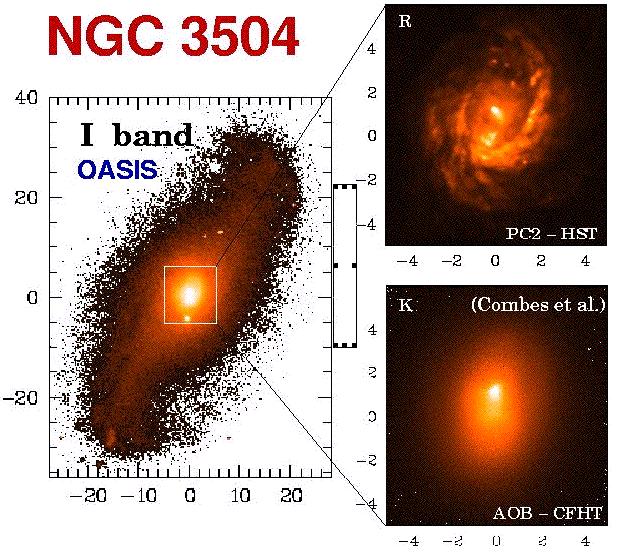
The double barred galaxy NGC 3504
Credit: Image courtesy of E. Emsellem
CRAL-Observatoire de Lyon, Lyon, France

Bars are ubiquitous in spiral galaxies (they are found in more than
70% of them). Bars are density waves generated by gravitational
instabilites or galaxy collisions. They are made of stars and
gas and play an essential role both in the dynamics and evolution of
galaxies. In particular, they may help fuel the central regions of
galaxies with gas and dust by allowing these components to lose part
of their angular momentum. Bars may thus be responsible for the
intense activity seen in the so-called Active Galactic Nuclei or AGN.
However there seems to be no link between the presence of an active
nucleus and the existence of a bar. One of the reason invoked to
explain this is that a large-scale bar can usually drag the gas within
the central kpc or so, but then other processes should take the relay.
Recent studies have revealed bars within bars, which may play such a
role. These smaller scale nuclear bars have now been observed in many
spirals, but up to now, mostly studied through imaging. Spectroscopic
observations are required to determine the stellar and gas
dynamics in the central kpc of double-barred galaxies, and understand
the link with the central activity or starburst.
We present here observations obtained with
OASIS at the CFHT of NGC 3504, a nearby double-barred galaxy.
OASIS in an integral field spectrograph working in the optical domain
allowing to get simultaneously 1200 spectra over a field of view of
typically 10 arcseconds. The images in the
top show direct images of the central regions of NGC 3504
obtained respectively with OASIS (I band),
the HST (I band) and the adaptive optics of the CFHT (PUEO). The
central elongated structure is clearly seen as well as a strong
asymmetry appearing as a one-arm spiral arm in the visible and as an
offset nuclear structure in the infrared. The bright secondary source
at about 6 arcsecond south is a supernova discovered during the OASIS
observations (1998cf). The bottom left panels
show some OASIS spectra tracing the stellar component of the
Galaxy. The Ca triplet seen in absorption in the central regions is
used to derive the stellar velocity field. Broad Ca lines are also
seen in emission at the location of the supernova.
The right panels show reconstructed
images in different emission lines which trace the ionised gas
distribution. The varying morphology of these maps reflect the
different physical states of the core and nuclear arm regions.
The study of this data set will help determine the
detailed internal dynamics in the nuclear regions, and understand the
role of the nuclear bar and the asymmetry in the context of the
central nuclear fueling mechanism.
OASIS is an integral field spectrograph working in the optical
domain and providing simultaneously 1200 spectra. A micro-lens array
splits the input image into small micro-pupils. Each pupil is then
dispersed in the spectrograph stage and imaged on the detector. The
observations presented here were obtained in March 1998 and November
1999. The sampling used was 0.4 arcsec giving a total field of view
of 12"x15". Two spectral configurations were used: one in the red
(around 8500 Angs) to study the stellar kinematics and one in the blue
(6300 to 7000 Angs) to study the gaseous component The seeing was
around 1 arsec in the red, 0.8 arcsec in the blue.
Technical description:



